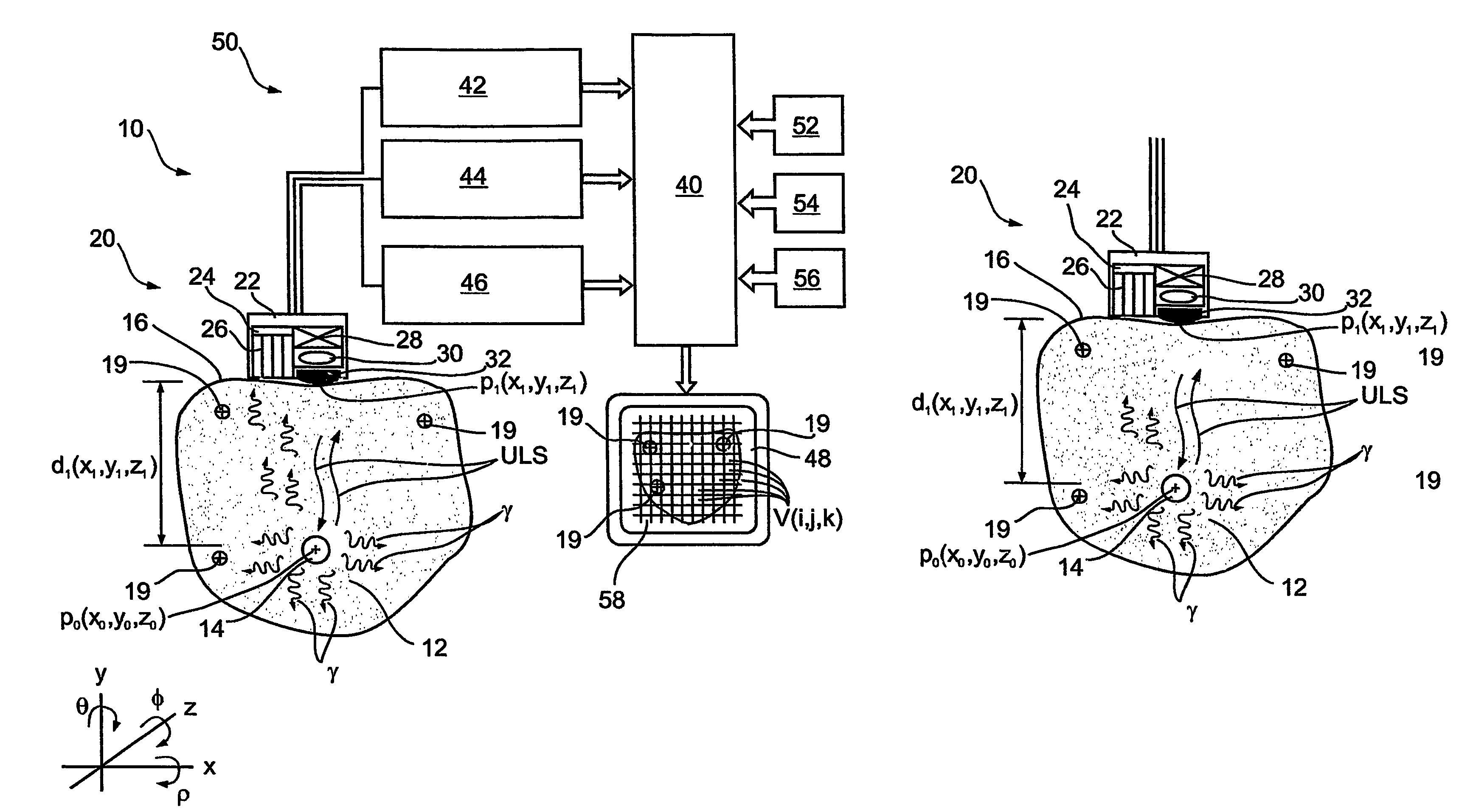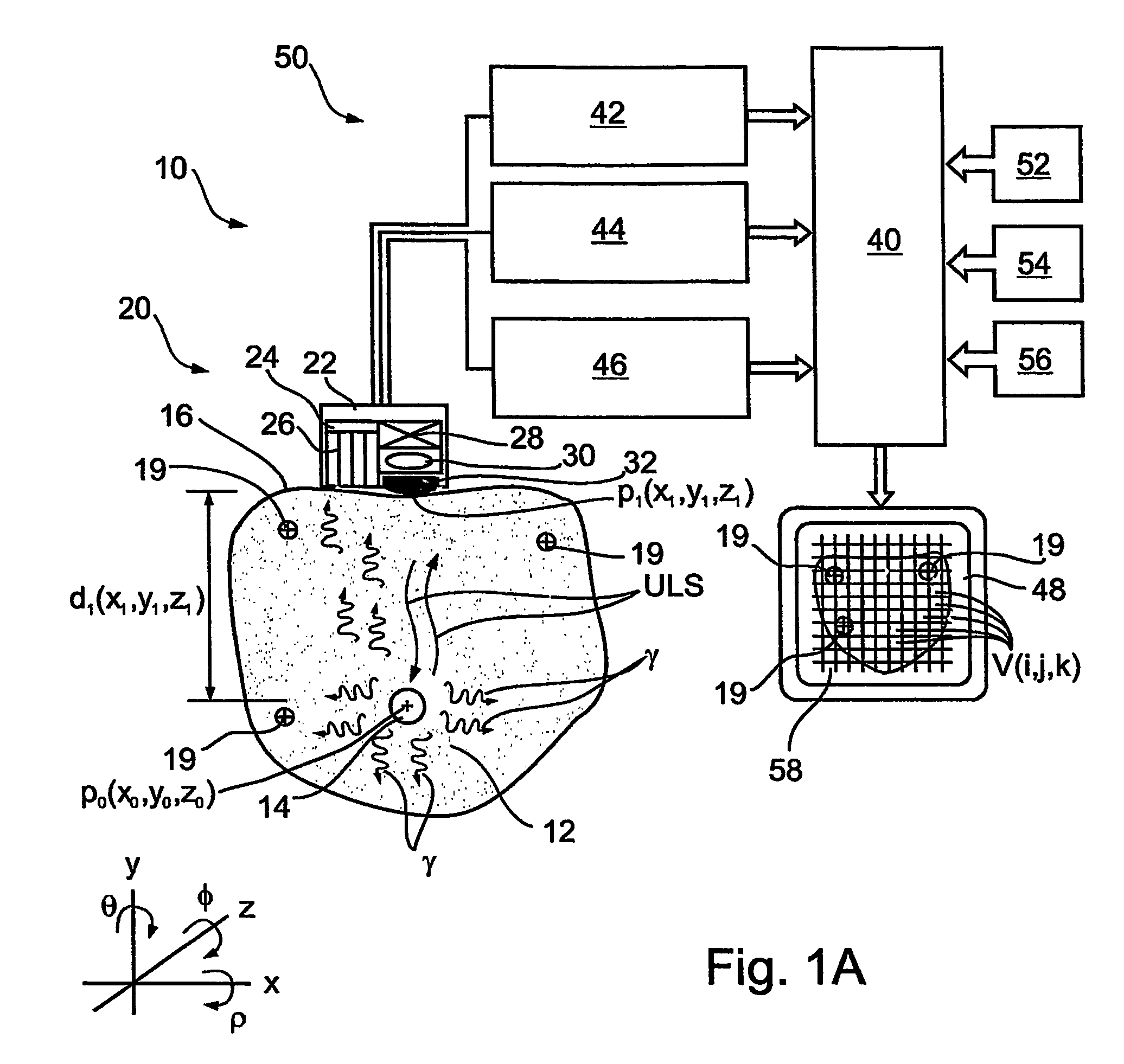Apparatus and methods for imaging and attenuation correction
a technology of attenuation correction and apparatus, applied in the field of nuclear radiation imaging integration, can solve the problems of affecting the clinical potential of radionuclide imaging, the functional image may not show structural details, and the image fusion may be somewhat erroneous,
- Summary
- Abstract
- Description
- Claims
- Application Information
AI Technical Summary
Problems solved by technology
Method used
Image
Examples
example 1
[0256]Referring further to the drawings, FIGS. 4A-4E schematically illustrate a handheld system 100 for simultaneous nuclear-radiation and ultrasound imaging, in accordance with the present invention, as taught in conjunction with FIG. 1A, hereinabove.
[0257]Handheld system 100 is adapted to perform freehand, extracorporeal scanning by nuclear radiation and ultrasound, simultaneously. Additionally, computer system 50 (FIG. 1A) is adapted to receive input from handheld system 100 and provide an attenuation-corrected nuclear-radiation image as well as a superposition of the attenuation-corrected nuclear-radiation image and the ultrasound image, for example, on display screen 48. Furthermore, handheld system 100 may be operative to guide an in-vivo instrument tip 25 (FIG. 1H) based on the superposition of the attenuation-corrected nuclear-radiation image and the ultrasound image, for example, as seen on display screen 48 (FIG. 1H).
[0258]As seen in FIG. 4A, handheld system 100 preferably...
example 2
[0273]Referring further to the drawings, FIGS. 4F-4J schematically illustrate a handheld system 140 for simultaneous nuclear-radiation and ultrasound imaging, in accordance with the present invention, as taught in conjunction with FIG. 2A, hereinabove.
[0274]System 140 is analogous to system 70 of FIG. 2A. Thus, two separate handheld probes: probe 72 for nuclear radiation imaging and probe 76 for ultrasound are used, both having substantially identical position registering devices 30A and 30B. The manner of using system 140 is similar to that of using system 100, however, in place of simultaneous scanning, for nuclear radiation and ultrasound, each is performed individually, and computer system 50 combines the results.
[0275]Thus, handheld system 140 is adapted to perform freehand, extracorporeal scanning by nuclear radiation and ultrasound. Additionally, computer system 50 (FIG. 2A) is adapted to receive input from handheld system 140 and provide an attenuation-corrected nuclear-radi...
example 3
[0279]Referring further to the drawings, FIGS. 5A and 5E schematically illustrate a rectal probe 200 for simultaneous nuclear-radiation and ultrasound imaging, in accordance with the present invention, as taught in conjunction with FIG. 1A, hereinabove.
[0280]Rectal probe 200 is adapted to perform intracorporeal scanning of the rectum by nuclear radiation and ultrasound, simultaneously. Additionally, computer system 50 (FIG. 1A) is adapted to receive input from rectal probe 200 and provide an attenuation-corrected nuclear-radiation image as well as a superposition of the attenuation-corrected nuclear-radiation image and the ultrasound image, for example, on display screen 48. Furthermore, rectal probe 200 may be operative for focused ablation, for example, of a tumor, based on the superposition of the attenuation-corrected nuclear-radiation image and the ultrasound image.
[0281]As seen in FIGS. 5A-5B, rectal probe 200 includes an intracorporeal portion 112, for insertion to the rectum...
PUM
 Login to View More
Login to View More Abstract
Description
Claims
Application Information
 Login to View More
Login to View More - R&D
- Intellectual Property
- Life Sciences
- Materials
- Tech Scout
- Unparalleled Data Quality
- Higher Quality Content
- 60% Fewer Hallucinations
Browse by: Latest US Patents, China's latest patents, Technical Efficacy Thesaurus, Application Domain, Technology Topic, Popular Technical Reports.
© 2025 PatSnap. All rights reserved.Legal|Privacy policy|Modern Slavery Act Transparency Statement|Sitemap|About US| Contact US: help@patsnap.com



